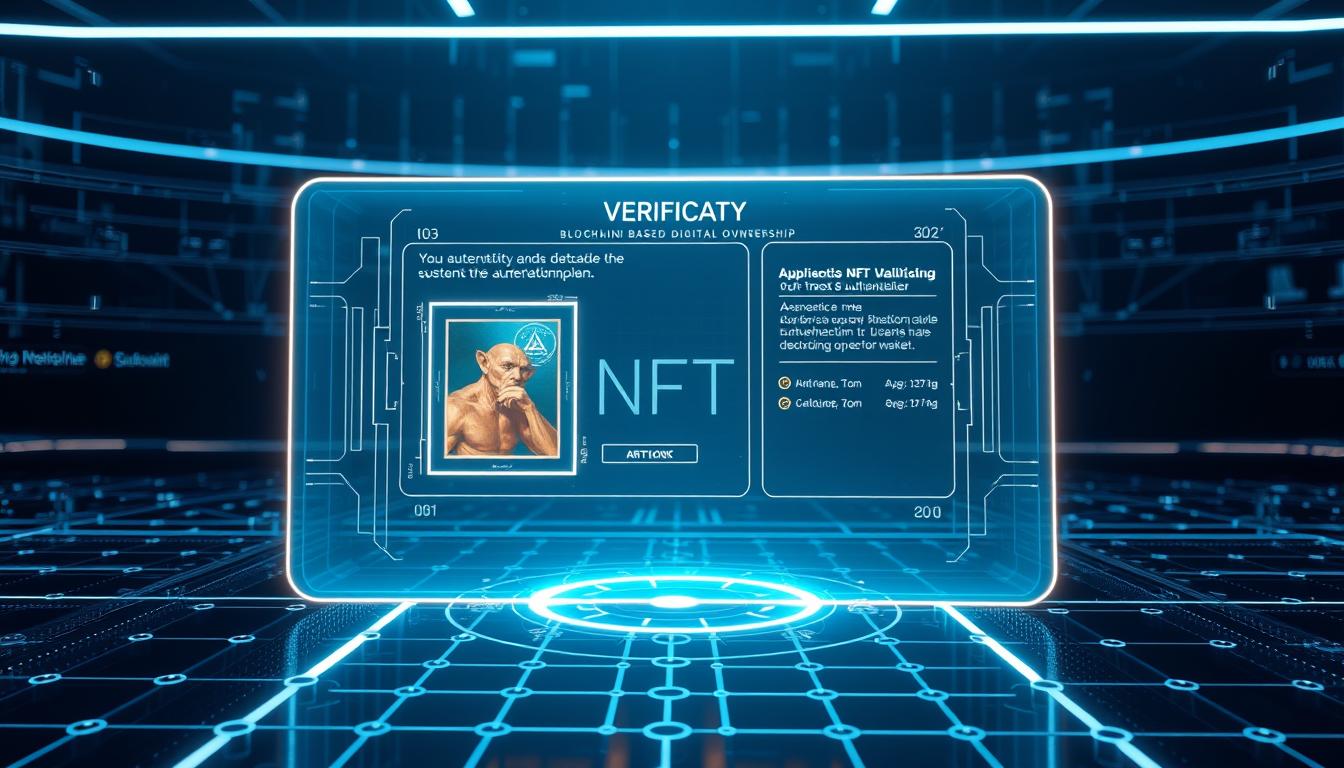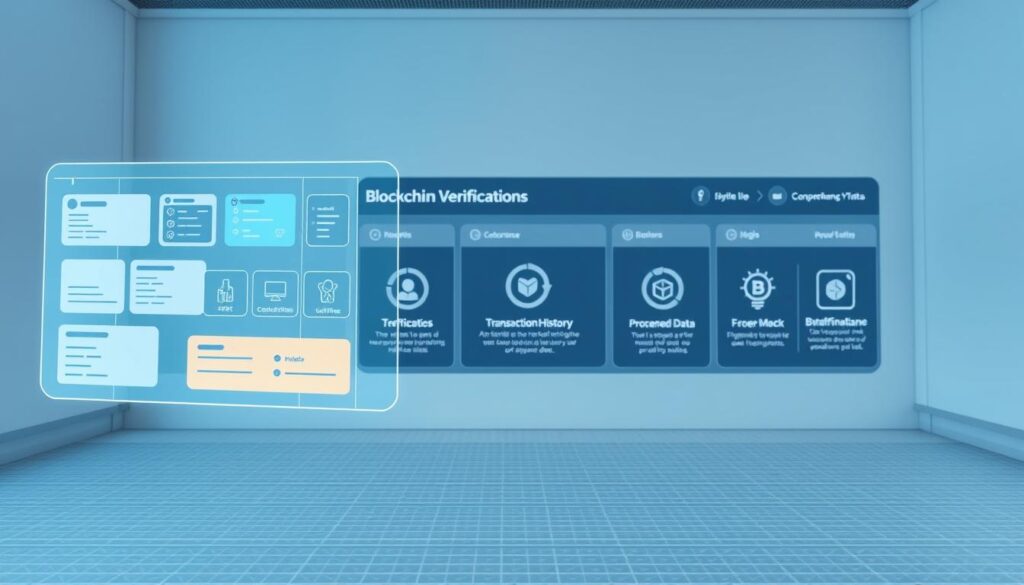Now Reading: NFT Authentication & Provenance Verification: Tools for Buyers, Sellers
- 01
NFT Authentication & Provenance Verification: Tools for Buyers, Sellers
NFT Authentication & Provenance Verification: Tools for Buyers, Sellers

Global markets face a $2 trillion challenge: counterfeit goods. Fake products damage trust between brands and consumers. Traditional paper certificates struggle to keep up with sophisticated fraud methods. This creates urgent demand for reliable solutions.
New technologies now offer unbreakable proof of ownership. Blockchain records provide permanent, transparent histories for items. Digital certificates linked to physical or virtual assets prevent tampering. These systems give buyers confidence in their purchases.
Businesses gain powerful tools to protect their products. Immutable records help companies prove item origins and ownership chains. This technology isn’t just about security – it creates new ways to engage customers. Brands can attach exclusive content or experiences to verified items.
The shift to digital verification affects multiple industries. Art, luxury goods, and collectibles already use these systems. Even everyday products benefit from enhanced trust features. As adoption grows, consumers expect proof of authenticity before purchasing.
Key Takeaways
- Counterfeit goods cost global markets $2 trillion yearly
- Blockchain creates permanent ownership records
- Digital certificates work for physical and virtual items
- New customer engagement opportunities emerge
- Multiple industries now use verification systems
- Consumers increasingly demand proof of authenticity
Introduction to Digital Authentication in the NFT Era
Modern markets require unalterable proof of asset origins. Traditional paper documents often fail to prevent sophisticated fraud. Blockchain solutions now offer indisputable ownership tracking through encrypted digital records.
Digital certificates use cryptography to link assets with their rightful owners. Unlike physical paperwork, these records exist on decentralized networks. This approach removes reliance on single authorities that hackers could target.
| Feature | Traditional Certificates | Blockchain-Based Certificates |
|---|---|---|
| Security Level | Easily forged | Cryptographically secured |
| Accessibility | Physical storage | Global digital access |
| Update Capability | Manual revisions | Permanent history |
| Verification Speed | Days/weeks | Instant checks |
High-value art markets demonstrate this technology’s impact. Auction houses now attach unique digital signatures to artworks. Buyers instantly confirm creation dates and ownership chains through public ledgers.
Advanced algorithms protect these systems from tampering. Each transaction receives a mathematical fingerprint that changes if altered. This process ensures lasting authenticity guarantees without third-party oversight.
Understanding Blockchain Technology and Its Role in Verification
Digital trust demands systems that resist manipulation. Blockchain technology powers these frameworks through its unique architecture. Unlike traditional databases, it operates as a shared digital ledger updated across thousands of computers simultaneously.

Decentralization and Immutability Explained
Blockchain removes central control points. Every transaction gets copied to multiple nodes – independent computers in the network. This structure prevents single entities from altering historical records.
Once data enters the ledger, it becomes permanent. Network participants must agree on changes through consensus mechanisms. This immutability creates reliable audit trails for high-value transactions.
| Aspect | Traditional Systems | Blockchain Systems |
|---|---|---|
| Data Storage | Central servers | Distributed nodes |
| Security Model | Password protection | Cryptographic hashing |
| Update Process | Admin-controlled | Network consensus |
| Record History | Editable | Permanent |
How Blockchain Secures Digital Assets
Three-layer protection safeguards blockchain records. First, mathematical puzzles verify transactions. Next, digital signatures confirm participant identities. Finally, network-wide agreement locks entries into the chain.
Financial institutions now use this multi-layered security for asset transfers. Luxury brands apply similar methods to track product journeys. Each application demonstrates blockchain’s capacity to prevent unauthorized changes.
Real-time validation separates this technology from older systems. Transactions complete in minutes instead of days. This speed enhances trust while maintaining rigorous security standards.
The Evolution of NFT Authentication and Provenance
Digital collectibles transformed ownership tracking through blockchain innovation. Early systems used basic tokenization methods without standardized verification. This changed when developers created protocols like Ethereum’s ERC-721, which pioneered non-fungible tokens with unique identifiers.
Smart contract advancements enabled cross-platform compatibility. The ERC-1155 standard later allowed mixed token types within single contracts. These frameworks established rules for secure transfers and permanent ownership records.
Three critical developments shaped modern systems:
- Metadata standardization for detailed asset information
- Interoperability agreements between marketplaces
- Automated royalty distribution mechanisms
Ownership tracking shifted from paper trails to encrypted blockchain entries. Each transaction now leaves permanent markers, creating unbroken historical chains. This progression addresses growing demands for transparent asset histories.
Market forces accelerated these technological improvements. Early platforms demonstrated how standardized protocols build user trust. Their approaches continue influencing new verification methods across industries.
NFT authentication and provenance verification tools for buyers and sellers
Modern commerce benefits from ready-made solutions that eliminate custom development needs. Open blockchain standards enable instant checks across platforms through shared protocols. These systems allow anyone to confirm an item’s history using public ledgers.

Operational Mechanics of Modern Systems
Third-party validation becomes unnecessary through decentralized networks. Users scan unique codes or digital signatures tied to assets. The blockchain returns complete ownership timelines and creation details automatically.
| Process Step | Traditional Method | Blockchain Approach |
|---|---|---|
| Ownership Check | Manual document review | Instant ledger query |
| History Access | Partial records | Complete timeline |
| Fraud Prevention | Reactive measures | Built-in safeguards |
Essential Advantages for Market Participants
Purchasers gain three critical protections:
- Immediate confirmation of item origins
- Automatic counterfeit detection
- Full transfer history visibility
Commerce platforms benefit through:
- Streamlined certificate generation
- Reduced dispute resolution costs
- Enhanced marketplace credibility
Integration occurs seamlessly through API connections. Major retailers embed verification widgets directly into product pages. This accessibility drives adoption across industries while maintaining enterprise-grade security.
Enhancing Consumer Trust Through Blockchain-Based Verification
Market confidence grows when proof becomes undeniable. Blockchain technology reshapes how people confirm product legitimacy, moving trust from promises to provable facts. A simple scan or search reveals entire ownership histories, cutting through uncertainty.

Establishing Transparency and Traceability
Modern verification systems turn complex histories into accessible data. Every item receives a unique digital identity stored on decentralized ledgers. Brands and customers access identical information, removing doubts about edited records.
| Feature | Traditional Methods | Blockchain Solutions |
|---|---|---|
| Access Point | Single source | Global network |
| Update Frequency | Delayed | Real-time |
| Audit Capability | Limited | Full history |
| Trust Mechanism | Institutional | Mathematical |
Luxury watchmakers now embed scannable chips linking to blockchain records. Buyers see manufacturing dates, materials used, and past owners within seconds. This direct access reduces reliance on middlemen.
Digital art platforms use similar systems. Creators attach certificates to their works, visible to all potential buyers. This openness creates fairer pricing and lasting buyer-seller relationships.
Three key shifts drive adoption:
- Instant validation replaces weeks-long checks
- Shared data access balances buyer-seller knowledge
- Permanent records prevent historical revision
Consumers report higher satisfaction when using self-verification tools. Brands using these systems see repeat purchases increase by 34% according to recent retail studies.
Countering Fraud with Tamper-Proof Digital Certificates
Fraudulent activities cost businesses billions annually through fake products and forged documents. Blockchain-powered digital certificates create ironclad proof of ownership that criminals can’t replicate. Each certificate acts like a digital fingerprint, permanently tied to its original item through encrypted records.

- Cryptographic hashing seals data with unique mathematical signatures
- Distributed validation requires network-wide consensus for changes
- Time-stamped entries create irreversible transaction histories
Luxury brands now embed scannable chips in products linking to blockchain records. When a counterfeit Rolex appears, buyers compare physical details against permanent digital records. Mismatches trigger immediate fraud alerts, stopping scams before money changes hands.
Pharmaceutical companies use similar systems to track drug shipments. Each package receives a tamper-proof certificate updated at every distribution point. Patients verify medicine origins through mobile apps, reducing counterfeit drug risks by 89% in pilot programs.
These solutions cut dispute resolution costs by 40% for early adopters. Businesses report fewer chargebacks and stronger customer loyalty when using verifiable authenticity systems. As forgers develop new tactics, blockchain protocols automatically update to counter emerging threats.
Leveraging Smart Contracts and NFT Signatures for Authenticity
Digital agreements now enforce themselves through code. Smart contracts automate trust by executing predefined rules when conditions meet. These blockchain-based tools eliminate paperwork delays while maintaining ironclad security standards.
Understanding Smart Contracts
Self-operating agreements run on blockchain networks without intermediaries. Terms convert into code that triggers actions automatically. For example, a smart contract could release payment only after confirming an item’s authenticity through linked records.
| Feature | Traditional Contracts | Smart Contracts |
|---|---|---|
| Execution | Manual enforcement | Automatic triggers |
| Verification | Third-party review | Built-in checks |
| Speed | Days/weeks | Minutes |
The Security of NFT Signatures
Unique digital markers replace easily copied signatures. Each signature becomes a blockchain token with encrypted ownership data. This method prevents forgery better than PDF certificates or scanned handwriting.
Three layers protect these systems:
- Mathematical proofs lock signatures to specific documents
- Ownership histories show every usage instance
- Decentralized validation rejects altered files
Art collectors use NFT-based solutions to sign limited editions securely. Legal firms apply similar technology for tamper-proof contracts, reducing fraud risks identified in blockchain research studies.
Exploring Leading Tools and Platforms for Provenance Verification
Industry leaders now deploy advanced systems to combat counterfeits. The Aura Blockchain Consortium – formed by luxury powerhouses like Louis Vuitton and Prada – uses shared verification platforms for high-end goods. Their collaborative approach standardizes item tracking across brands through encrypted blockchain entries.
Watchmaker Vacheron Constantin embeds digital certificates during production. Each timepiece carries immutable manufacturing details accessible via mobile scans. Louis Vuitton’s patent-pending authentication solution links physical products to blockchain records, creating seamless ownership proof.
Three key features define modern platforms:
- Cross-brand compatibility through open standards
- Real-time validation via decentralized networks
- Integrated history tracking from creation to resale
These solutions help businesses maintain control while giving buyers instant access to provenance data. As adoption grows, expect more industries to adopt similar verification tools for protecting brand value and consumer trust.














